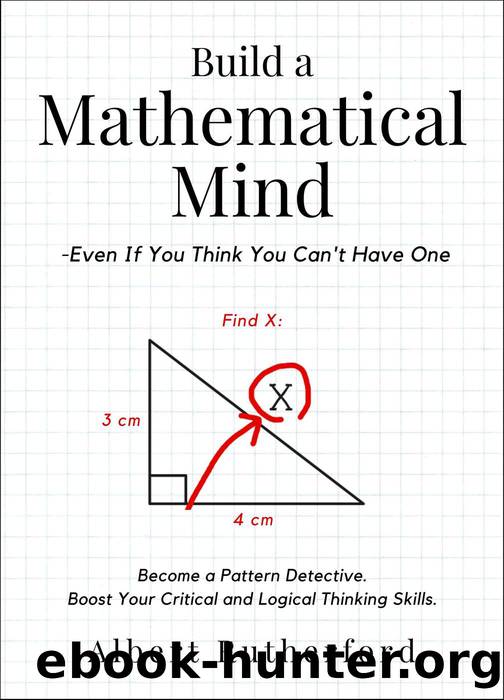Build a Mathematical Mind--Even If You Think You Can't Have One by Albert Rutherford

Author:Albert Rutherford
Language: eng
Format: epub
Tags: mathematics, how to learn math, mathematical mindset, logic, math skills
Publisher: Albert Rutherford
Published: 2023-01-31T00:00:00+00:00
CHAPTER 7: Visualizing: Externalizing the Internal
If youâve ever spent time with a gymnast, a concert pianist, or anyone else performing at an elite level, you may have seen them visualizing a performance: imagining every step of it, trying to picture themselves performing it perfectly. You may have wondered why they were doing this rather than spending time practicing leaps or scales. They know something mathematicians also know: visualizing is a powerful tool.
Mathematicians are skilled at visualizing. Einstein attributed his success to the skill: âMy particular skill does not lie in calculation,â he wrote, âbut rather in visualizing effects, possibilities, and consequences.â[xlv] It makes sense that visualizing holds such power for humans. Approximately 30% of the brains of primates (which includes humans) is used for visual processing.[xlvi] No wonder we are such visual creatures.
Researchers have identified five aspects of visualizing: internalizing, identifying, comparing, connecting, and sharing.[xlvii] We will examine each of these and discuss how you can hone these skills to incorporate visualizing into your life.
Internalizing involves making sense of something in your head. This is the first step to understanding a problem, particularly a complex one. Letâs imagine youâre trying to do something that challenges most people: packing a car for a big trip. People who are good at fitting everything into the back of a car arenât magicians; theyâre just good at internalizing a spatial problem.
When someone gets ready to pack a bunch of suitcases and bags into the trunk of a car, they need to spend time internalizing the problem first. They might ask themselves: How many large suitcases are there? What irregular objects do I need to get in? Are there pockets of space somewhere, maybe under the back seats, where certain items would fit? Where can I put the bag of fragile items, so itâs protected and not squished?
The talented packer spends time picturing the answers to these questions and manipulating items in their head before packing the car. If you watch this person in action, youâll see they rarely have to pack and repack the car. They are strategic about what they put where, and they get everything in securely. This is because they spent time internalizing the problem and have a plan for how to solve it.
The identifying stage of visualization involves identifying or creating an image or model that might help you. Young students learn to do this to help them solve math problems. Many teachers use a strategy called, âRead, Draw, Write,â which asks students to draw a model or picture to help them solve word problems. They are supposed to read the problem, draw a model, then write the answer in a sentence. The RDW strategy was not created to torture kids or the parents trying to help them with their homework. Rather, it is based on research about how visualization, particularly the act of drawing, creates a stronger understanding and memories of the problem.[xlviii] The process of creating a model leads to better understanding.
Sometimes, weâre faced with problems that beg for a drawing to help us solve them.
Download
This site does not store any files on its server. We only index and link to content provided by other sites. Please contact the content providers to delete copyright contents if any and email us, we'll remove relevant links or contents immediately.
| Algebra | Calculus |
| Combinatorics | Discrete Mathematics |
| Finite Mathematics | Fractals |
| Functional Analysis | Group Theory |
| Logic | Number Theory |
| Set Theory |
Modelling of Convective Heat and Mass Transfer in Rotating Flows by Igor V. Shevchuk(6391)
Weapons of Math Destruction by Cathy O'Neil(6148)
Factfulness: Ten Reasons We're Wrong About the World – and Why Things Are Better Than You Think by Hans Rosling(4694)
Descartes' Error by Antonio Damasio(3231)
A Mind For Numbers: How to Excel at Math and Science (Even If You Flunked Algebra) by Barbara Oakley(3221)
Factfulness_Ten Reasons We're Wrong About the World_and Why Things Are Better Than You Think by Hans Rosling(3199)
TCP IP by Todd Lammle(3137)
Fooled by Randomness: The Hidden Role of Chance in Life and in the Markets by Nassim Nicholas Taleb(3048)
Applied Predictive Modeling by Max Kuhn & Kjell Johnson(3019)
The Tyranny of Metrics by Jerry Z. Muller(3003)
The Book of Numbers by Peter Bentley(2912)
The Great Unknown by Marcus du Sautoy(2648)
Once Upon an Algorithm by Martin Erwig(2599)
Easy Algebra Step-by-Step by Sandra Luna McCune(2585)
Lady Luck by Kristen Ashley(2534)
Practical Guide To Principal Component Methods in R (Multivariate Analysis Book 2) by Alboukadel Kassambara(2497)
Police Exams Prep 2018-2019 by Kaplan Test Prep(2487)
All Things Reconsidered by Bill Thompson III(2358)
Linear Time-Invariant Systems, Behaviors and Modules by Ulrich Oberst & Martin Scheicher & Ingrid Scheicher(2334)
